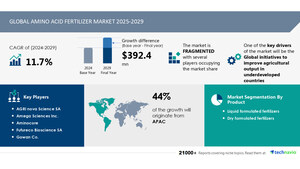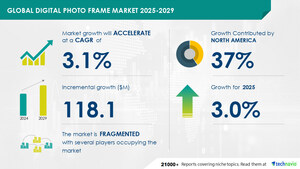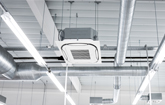NEW YORK, March 14, 2024 /PRNewswire/ -- The global air quality monitor market size is estimated to grow by USD 2 billion from 2022 to 2027, according to Technavio. The market is estimated to grow at a CAGR of 6.99% during the forecast period. The escalating demand for Indoor Air Quality (IAQ) monitoring in both residential and commercial sectors is fueling the global market's growth. With worsening environmental conditions, there's a surge in severe health issues and mortality rates linked to air pollution, as highlighted in the 2021 WHO report. Particularly, regions like India and South Africa face heightened exposure due to factors like increasing vehicle ownership and industrialization. Moreover, the implementation of international standards such as LEED and WELL underscores the urgency for sustainable building practices, further propelling the market. As the need for monitoring systems intensifies, the market is poised for significant expansion in the forecast period.
For more insights on the historic market data (2017 to 2021) and forecast market size (2023 to 2027) - Request a sample report
Segment Overview
Technavio has segmented the market based on Product (Indoor, Outdoor, and Wearable), End-user (Government, Commercial and residential, Energy and pharmaceuticals, and Others), and Geography (North America, Europe, APAC, Middle East and Africa, and South America).
- The indoor segment is significant during the forecast period. Indoor air quality monitors are crucial devices designed to assess and maintain healthy indoor environments in homes, offices, and other buildings. Equipped with sensors, they detect pollutants, ventilation issues, and other factors, addressing the growing awareness of health risks and the emphasis on sustainable construction practices. This drives market growth.
Geography Overview
North America held the largest share of the global market in 2022, and the market in the region is estimated to witness an incremental growth of 33%. By geography, the global air quality monitor market is segmented into North America, Europe, APAC, Middle East and Africa, and South America. The report provides actionable insights and estimates the contribution of all regions to the growth of the global air quality monitor market.
Insights on the market contribution of various segments including country and region, historic market data (2017 to 2021), and forecast market size (2023 to 2027) - Download a Sample Report
Analyst Review
In today's world, the issue of air pollution has garnered significant attention from governments, environmental organizations, and health experts alike. With rapid urbanization, industrialization, and increasing vehicular emissions, the need for effective air quality monitoring systems has never been more pressing.
Government bodies such as the Central Pollution Control Board and the Environmental Protection Agency (EPA) have implemented stringent regulations to control air pollution levels. National Air Quality Monitoring Programme (NAMP) is one such initiative aimed at monitoring various pollutants like Carbon monoxide (CO), Nitrogen oxides (NO2 and NO3), Ozone (O3), Particulate matter (PM), Sulfur dioxide (SO2), and Volatile organic compounds (VOC) to ensure compliance with National Ambient Air Quality Standards (NAAQS).
The detrimental effects of poor air quality on human health cannot be overstated. Conditions such as asthma, diabetes, obstructive pulmonary disease, and cardiovascular diseases are exacerbated by exposure to pollutants. Recognizing the severity of this issue, organizations like the World Health Organization (WHO) have established Global Air Quality Guidelines (AQGs) to safeguard public health.
Advancements in technology have led to the development of advanced air quality monitoring sensors (AQM sensors) capable of accurately detecting various pollutants in real-time. Companies like Clarity Movement Co, 2B Technologies, and others have emerged as key players in this rapidly evolving market, offering innovative solutions to address the growing demand for air quality monitoring systems.
The urgency to combat air pollution on a global scale has prompted the establishment of initiatives like the National Clean Air Program (NCAP), which aims to reduce pollution levels and improve air quality in urban areas. Additionally, organizations such as the International Diabetic Federation recognize the interconnection between air quality and health outcomes, advocating for comprehensive approaches to tackle both issues.
While outdoor air pollution garners significant attention, indoor air quality is equally important, especially considering that individuals spend a substantial amount of time indoors. Indoor air quality monitors play a crucial role in identifying and mitigating indoor air pollutants, thus safeguarding the health and well-being of occupants.
In conclusion, the air quality monitor market is witnessing robust growth driven by increasing awareness of the health impacts of air pollution, stringent government regulations, technological advancements, and global initiatives aimed at improving air quality standards. As the importance of clean air continues to gain prominence, the demand for innovative air quality monitoring solutions is expected to soar in the coming years.
Market Overview
The global air quality monitoring system market is experiencing rapid growth driven by stringent government regulations like the National Air Quality Monitoring Programme (NAMP) enforced by agencies such as the Central Pollution Control Board and the EPA (Environmental Protection Agency). Compliance with NAAQS (National Ambient Air Quality Standards) is paramount, necessitating precise monitoring of pollutants such as carbon monoxide (CO), nitrogen oxides (NO2 and NO3), and ozone (O3). These regulations drive the demand for advanced air quality monitors capable of accurately measuring and analyzing pollutant levels. As environmental concerns escalate, the market for air quality monitoring systems is poised for continued expansion.
Related Reports:
The Residential HVAC Market is forecast to increase by USD 42.39 billion, at a CAGR of 8.56% between 2023 and 2028.
The non-residential HVAC rental equipment market size is estimated to grow at a CAGR of 5.52% between 2022 and 2027. The market size is forecast to increase by USD 1,565.69 million.
ToC:
1 Executive Summary
2 Landscape
3 Sizing
4 Historic Size
5 Five Forces Analysis
6 Segmentations
7 Customer Landscape
8 Geographic Landscape
9 Drivers, Challenges, and Trends
10 Vendor Landscape
11 Vendor Analysis
12 Appendix
About US
Technavio is a leading global technology research and advisory company. Their research and analysis focus on emerging market trends and provide actionable insights to help businesses identify market opportunities and develop effective strategies to optimize their market positions. With over 500 specialized analysts, Technavio's report library consists of more than 17,000 reports and counting, covering 800 technologies, spanning 50 countries. Their client base consists of enterprises of all sizes, including more than 100 Fortune 500 companies. This growing client base relies on Technavio's comprehensive coverage, extensive research, and actionable market insights to identify opportunities in existing and potential markets and assess their competitive positions within changing market scenarios.
Contact
Technavio Research
Jesse Maida
Media & Marketing Executive
US: +1 844 364 1100
UK: +44 203 893 3200
Email: [email protected]
Website: www.technavio.com
SOURCE Technavio

WANT YOUR COMPANY'S NEWS FEATURED ON PRNEWSWIRE.COM?
Newsrooms &
Influencers
Digital Media
Outlets
Journalists
Opted In





Share this article